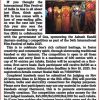Goa is abuzz with excitement as vintage bike and car owners, users, collectors and fans are decking […]

GOA IS DUBAI FOR MIGRANTS
Migrants, Oct 20-Oct 26 2018 October 20, 2018XITT KODI: Most of the staff employed on fishing trawlers are migrants from outside the state, although the trawlers themselves are owned by Goans
BY RAJAN NARAYAN
Goa has become a melting point for migrants from all over the country, almost echoing the National Anthem — Punjab, Sindh, Gujarata, Maratha, Drawida Utakala Bangla — and with the addition of the Northeast also. They are attracted by the high wages but Goans fear that they may soon loose their identity
In most states of the country there is been tension between migrants and locals. It began with the Shiv Sena in Mumbai targeting the large south Indian community, particularly the Udipi hotels on which Mumbaikars are dependent for economical lunches and dinners. This backfired as there were protests from locals themselves. The attacks were motivated by the fact that the Shiv Sena was set up to ensure that the people of Maharashtra get preference in jobs. The slogan was ‘protecting the Marathi manus’.
The next targets of the Shiv Sena were the Biharis who dominate the taxi trade and interestingly, the distribution of newspapers and magazines. They are also a very large part of the labour force in Mumbai. The Congress MP Nirupam Sawant rightly boasts that Mumbai will shut down if the UP bhaias go on strike. Which is true to a very large extent. The excuse for targeting migrants has always been too many people seeking jobs and not enough jobs available. To its credit the Shiv Sena created job opportunities for the Marathi manus by giving them a monopoly over batatawada stalls all over the city. Efforts were continuously made to make sure that industries and hotels and even hospitals give preference in employment to locals.
The biggest movement against migrants was launched recently by the BJP government in Assam. There has always been a simmering problem in Assam over migrants from Bangladesh. Migrants from Bangladesh have not only entered Assam, which shares its border with Bangladesh, in very large numbers, but have spread out to every part of the country. There have been times where I was surprised to see Bangladeshis working as cooks and waiters in restaurants in Goa. There is been a long standing demand to create a citizens register which will distinguish genuine Assamese from Bangladeshis. This exercise was undertaken by the Census Office and the draft results have been announced. Overnight over 40 million residents of Assam, predominantly Muslims, have been declared outsiders or bhailes as we call them in Goa and may have to go back to Bangladesh.
Clashes between migrants and locals were common in Mumbai as long as the BIMARU states remained backward. But in recent years many states, including Bihar, have witnessed rapid development under Nitesh Kumar. The condition of other states like UP and MP has also changed. So the extent of migration from the poor states in the north to the big cities in the country like Mumbai and Kolkata have lessened. Ironically, while the demand for migrants has reduced in Mumbai, there have been a sharp increase for migrant labour in Kerala and Goa.
There is a common reason why Goa and Kerala are still very heavily dependent on migrants. A large majority of the people of both Kerala and Goa have migrated to the Gulf. Indeed, Keralites run some of the biggest hospitals and industrial units in the Gulf. The other common factor is that like Goans, Keralites do not do manual labour in their own backyard. So they need migrants to build their homes and collect their garbage and repair their ACs and electrical appliances.
Most migrants are happier in Goa then in Kerala. This is because there is no discrimination or hostility against migrants in Goa. Though the wages in Goa are equal to that of Kerala, language is the big barriers in Kerala. Whether you are a migrant or not, unless you can speak Malayalam you’ll have difficult time in Kerala. But in cosmopolitan Goa everyone speaks a little Hindi. And over the years so many migrants from different states have come to Goa that they have been able to form associations of their own and celebrate their festivals. They can keep in touch with their home state culture through their community associations.
Right now for instance the Bengalis in Goa are celebrating Durga Pooja, which my good friend Nibedita of Gomantak Times points out is very different from Dussehra. According to her Durga Pooja is more of cultural festival then a religious festival. The large Gujarati community celebrates Dusherra with the dandiya ras dance which culminates in a dandiya disco competition at the end of Navaratri. Not surprisingly the dandiya celebration is sponsored by Lata and Yatin Parekh. The latter, who owns Little Collection and the restaurant in Children’s Park, was mayor of Panjim for sometime.
The Oriyas, whose numbers have reached critical mass, even celebrated Lord Jaganath festival in Panjim some time ago. The Oriyas are primarily employed in Goa as watchmen without any training or experience for the job. But the labour shortage for unskilled jobs is so high that anybody is welcomed and gets a job almost immediately.
I remember when I had a heart attack and was in GMC. I desperately needed an attendant. An agency which is Aldona based but has a branch in Merces very promptly sent me an attendant. He was from the North East and had just arrived the previous day with no experience in any field.
FIRST MIGRANTS
The first wave of migrants to Goa, though they may not like to be reminded of it, were the Saraswats who claimed to have come from Kashmir and Bengal.
They very quickly took control of not only temples but even the business houses in Goa. Goa is the only state where the majority of the large business houses are controlled not by the business community, namely the Bhandaris in Goa, but by the Saraswats. All the big mining groups like Fomento, the Dempos and the Salgaocars, are controlled by Saraswats. So is Caculo Mall and the automobile agencies including the Mercedes agencies.

CONTROLLED: Not just the meat and fish markets, but even the vegetable and flower markets in all major towns are controlled by the Muslim community
Catholic Saraswats also have played the major part of building the economy of Goa led by Pascol Menezes of the CMM group. The first three industrial licenses issued in Goa after Liberation were to the CMM group. The sons particularly Cesar Menezes is holding a flag high having developed Carter Wallace into a company which is 50 times bigger than when he took over the management. Cesar, also a pioneer in popularising sailing as a sport in Goa, and recently celebrated his 75th birthday. Cesar also runs the charitable CMM Polyclinic and hospital and finances a home for terminal cancer patients in Loutolim.
Second Wave
The second wave of migrants were the Maharashtrians and Kannadigas. Since the MGP formed the first government in Goa it was logical that it should encourage the migration from people from Maharashtra.
Dayanand Bandodkar, the first chief minister, was keen on very rapidly creating educational facilities for the backward classes who were neglected by the Portuguese. He set up thousands of primary schools for which the teachers came from Maharashtra. Sadly Bandodkar did not inquire too much about whether they were qualified for the job.
The Portuguese did not have any engineering colleges or even industrial training institutes. So all the personnel required for the electricity department and the pwd came from Karnataka and Maharashtra. Which is why even now you will see that the top jobs in the Electricity Department and PWD department are controlled by non-Goans. Both the Electricity Department chief and the PWD chief are migrants.
A lot of construction work was taken up after Liberation. Starting with restoring the bridges that the Portuguese army had destroyed while trying to slow down the Indian forces. So construction labour was desperately needed. Most of it came from Karnataka. All the government and private buildings in Goa have been built by labour from Karnataka. The labour themselves have not done badly for themselves as the 2nd and 3rd generation have been educated and moved out of the construction industry. They dominate the trades — as electricians, plumbers, AC mechanics, and even mobile technicians. As in the case of other migrants, once people discovered the paradise of Goa, they never went back. Many of the migrants from Karnataka Maharashtra and Kerala have permanently settled in Goa. You can see this in the GMC where there are whole lot of third generation Malayali nurses and even doctors.
MUSLIM INFLUX
There were very few Muslims in Goa at the time of Liberation. The percentage of Muslims in the total population was less then half percent. Most of the Muslims were Bori Muslims who had integrated with the local community. Muslim from Karnataka were brought to Goa by the then Vasco MLA Shaikh Ibrahim to work in the port city of Vasco da Gama. A huge colony called Phukatnagar came up in encroached land.
Post-Godhra riots in Gujarat, more Muslims started coming to Goa. The word spread that Goa was the most safe place for the Muslims community. Goa has not seen a single communal riot except for a minor clash in Curchorem instigated by the BJP. But even the BJP now recognises that with Muslims now constituting 14% to 18% of the population, they have to take them seriously if they want to win elections. For instance, former Chief Minister Digambar Kamat has been winning Margao only because of the Muslims in Moti Dongor.
There is no section of business or trade which does not have the imprint of migrants in the state. All the garbage collectors — whether in Panjim or other parts of the state — are migrants, because Goans will not take up such jobs.
Not surprisingly the president of the Fish Exporters Association is a migrant — Ibrahim Shaikh. It is not surprising the crew of

BESIEGED: Men relaxing on beaches in Goa are often hounded by migrant women who offer massages for exorbitant amounts. A photo that went viral this year and drew a lot of outrage, showed several women surrounding an European man and massaging his arms and legs. Many tourists report being hounded by beggars and by women and men who insist the tourists pay for massages or even photos with them. (Pic for representational purposes only)
the fishing trawler owned by Goans are largely migrants — if the migrants don’t come back in time, fishing activity is delayed.
There has been some tension between Goan Catholics and Muslim migrants, particularly in south Goa. This is because unlike the Hindus with whom they grew up under 400 years of Portuguese colonial group, Goans are not used to Muslims who have come into the state after Liberation.
When a community expands it will need more places of worship and it will need land for burial grounds. The tension that is heating up is about land. Goa is a small state were land values have shot up due to everyone in the world wanting a holiday home in Goa. Hence, there is no affordable housing for Goans and so they are naturally reluctant to offer or share land with Muslims for mosques and burial places.
This is compounded by the fact that the rivalry between the Sunnis and the Shias continues in Goa. A Muslim industrialist has built a mosque and madrasa and lot of land for housing members of his community. But he extends this facility only to Shias and not to Sunnis.
NORTHEAST WAVE
The latest wave of migrants are the people from the Northeast. They are very popular with the casinos and the beauty parlours because of their not-typically-Indian looks.
Many beauty parlours ask people from the Northeast to pretend that they are from Thailand, which is famous or notorious for massage parlours. The typically fair-skinned person from the Northeast looks like a ‘foreigner’ and is therefore more in demand from tourists. Now there are at least 10,000 from the Northeast and the number is growing everyday.
GOAN DUBAI
What attracts people from all over the country to Goa? The obvious answer is that the wages for casual unskilled labour is highest in Goa. Even if you want your compound cleaned you will have to pay a minimum of `500. Which adds up to `15,000 a month. If the migrant has a wife she can supplement the family earning by working as a domestic servant for which there is desperate shortage. Back in their village they can get at the most jobs which will give them `50 per day.
Whether it is the job of loaders at the airport or dealers in the casinos or electricians and plumbers, migrants can make much more in Goa than anywhere in the country and certainly much, much more than in their hometowns.
Goans want to go to Dubai or on a cruise liner for fatter salaries. For migrants, Goa is Dubai. Most importantly, unlike other states, Goans don’t have any problems with migrants so far as they are not taking the jobs Goans want. There will be a clash only if migrants start getting government jobs.















